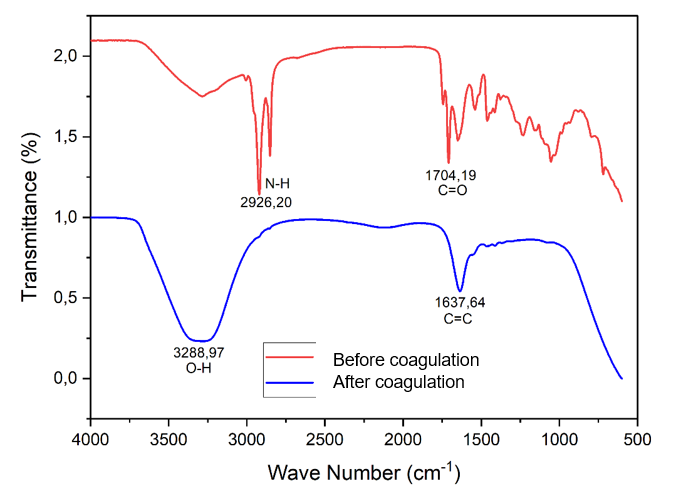Utilization of Moringa Seed Powder (Moringa Oleifera) as a Natural Coagulant for Reducing Pollution Parameters in Tofu Wastewater
DOI:
https://doi.org/10.59535/faase.v2i1.234Keywords:
Coagulation, Flocculation, Moringa Seeds, Natural Coagulant, Tofu WastewaterAbstract
The wastewater generated from the tofu industry often contains elevated levels of COD and TSS pollutants. One effective method for treating this wastewater is through the coagulation-flocculation process. Moringa seeds, recognized as a biomass with natural coagulant properties, contain a bioactive compound known as 4αL-rhamnosyloxy-benzyl-isothiocyanate, capable of adsorbing particles present in wastewater. The objective of this study is to assess the efficiency of reducing pollutant parameters (COD, TSS, and Turbidity) in wastewater from the tofu industry by utilizing Moringa seeds as a natural coagulant. The research was conducted using a jar test apparatus with coagulation stirring at 100 rpm and flocculation at 40 rpm for 12 minutes. The study involved varying coagulant doses (2, 3, 4, 5, and 6 g/L of tofu wastewater) and coagulation stirring times (1, 3, and 5 minutes). Based on the results obtained, the optimal stirring duration and dose, as well as the efficiency of reducing each pollutant parameter, were determined. For COD, the optimal conditions were found to be 3 minutes stirring time with a dose of 4 g/L, resulting in an efficiency of 64.88%. Similarly, for TSS parameters, the optimum conditions were achieved with 3 minutes of stirring time and a dose of 4 g/L, yielding an efficiency of 52.71%. Lastly, for turbidity, the most effective conditions were observed with 3 minutes of stirring time and a dose of 4 g/L, with an efficiency of 58.85%.
Downloads
References
R. A. Santoso, P. Fisika, and U. Jember, ‘Mekanisme teknologi bioreaktor membran (mbr) dalam mengatasi pencemaran air’, OPTIKA: Jurnal Pendidikan Fisika, vol. 7, no. 2, pp. 439–445, 2023.
E. Rizki and T. Agung, ‘Degradasi Limbah Tahu Dengan Koagulasi’, vol. 2, pp. 56–60, 2021.
N. Hendrasarie, F. R, R. H. Kokoh, and A. Andika, ‘Kombinasi Proses Koagulasi-Flokulasi Dengan Sequenching Batch Reactor Untuk Menurunkan Kandungan Organik Pada Limbah Batik’, Jukung (Jurnal Teknik Lingkungan), vol. 7, no. 2, pp. 131–139, 2021, doi: 10.20527/jukung.v7i2.11949.
H. Hendrawati, S. Sumarni, and . Nurhasni, ‘Penggunaan Kitosan sebagai Koagulan Alami dalam Perbaikan Kualitas Air Danau’, Jurnal Kimia VALENSI, vol. 1, no. 1, pp. 1–11, 2015, doi: 10.15408/jkv.v0i0.3148.
H. Kristianto, A. Jennifer, A. K. Sugih, and S. Prasetyo, ‘Potensi Polisakarida dari Limbah Buah-buahan sebagai Koagulan Alami dalam Pengolahan Air dan Limbah Cair: Review’, Jurnal Rekayasa Proses, vol. 14, no. 2, p. 108, 2020, doi: 10.22146/jrekpros.57798.
H. Kristianto, S. Prasetyo, and A. K. Sugih, ‘Pemanfaatan Ekstrak Protein dari Kacang-kacangan sebagai Koagulan Alami: Review’, Jurnal Rekayasa Proses, vol. 13, no. 2, p. 65, 2019, doi: 10.22146/jrekpros.46292.
S. R. Rachmawati, ‘Characterization of moringa (Moringa Oleifera Lam.) Leaf water extracts by chemical and microbiology Jurusan Analisa Farmasi dan Makanan Poltekkes Kemenkes Jakarta II Jl Raya Ragunan No . 29 C , Pasar Minggu , Jakarta Selatan . 12540 Email : sitirahayu.’, Jurnal Teknologi Dan Seni Kesehatan, vol. 10, no. 2, pp. 102–116, 2019.
A. Setiadi and E. Y. Hosang, ‘Characteristics of the moringa mother tree in the population of East Flores, East Nusa Tenggara’, Kultivasi, vol. 22, no. 2, pp. 168–173, 2023, doi: 10.24198/kultivasi.v22i2.47005.
H. Setyawati, ST. S. LA, and S. Andjar Sari, ‘Penerapan Penggunaan Serbuk Biji Kelor Sebagai Koagulan Pada Proses Koagulasi Flokulasi Limbah Cair Pabrik Tahu Di Sentra Industri Tahu Kota Malang’, Industri Inovatif : Jurnal Teknik Industri, vol. 8, no. 1, pp. 21–31, 2019, doi: 10.36040/industri.v8i1.669.
R. Putra, B. Lebu, M. H. D. D. Munthe, and A. M. Rambe, ‘Pemanfaatan Biji Kelor sebagai Koagulan pada Proses Koagulasi Limbah Cair Industri Tahu dengan Menggunakan Jar Test’, Jurnal Teknik Kimia USU, vol. 2, no. 2, pp. 28–31, 2013.
R. N. Amalia et al., ‘Potensi Limbah Cair Tahu sebagai Pupuk Organik Cair di RT. 31 Kelurahan Lempake Kota Samarinda’, ABDIKU: Jurnal Pengabdian Masyarakat Universitas Mulawarman, vol. 1, no. 1, pp. 36–41, 2022, doi: 10.32522/abdiku.v1i1.38.
Y. T. Amanda, Pemanfaatan biji trembeli (Samanea saman) sebagai koagulan alami untuk menurunkan BOD, COD, TSS, kekeruhan pada Pengolahan limbah cair tempe (Studi di Industri Tempe UD.X Kecamatan Patrang Kabupaten Jember). 2019.
J. Harahap, T. M. Ashari, and C. H. Munar, ‘Pemanfaatan Serbuk Biji Kelor (Moringa Oleifera) Sebagai Biokoagulan Pada Pengolahan Air Limbah Penatu’, Amina, vol. 4 no. 1, no. 1, pp. 7–16, 2022.
L. Hermida, J. Agustian, and B. Kurniasari, ‘Penggunaan Ekstrak Biji Kelor sebagai Biokoagulan pada Pengolahan Limbah Cair Laundry’, Jurnal Teknologi dan Inovasi Industri, vol. 02, no. 02, pp. 028–034, 2021.
K. Kumar and L. Trivedi, ‘Moringa oleifera seeds : An efficient & cost effective bio alternative for waste water treatment’, vol. 2, no. 5, pp. 40–45, 2017.
N. Hidayati, A. Setiawan, A. E. Afiuddin, and E. Yulianto, ‘Pengaruh Dosis Koagulan-Flokulan dalam Menurunkan Kandungan Zinc dan Fosfat Di Waste Water Treatment Plant (WWTP) PT POMI’, Conference Proceeding on Waste Treatment Technology, vol. 2, no. 2010, pp. 119–126, 2018.
D. P. W. Sheng, M. R. Bilad, and N. Shamsuddin, ‘Assessment and Optimization of Coagulation Process in Water Treatment Plant: A Review’, ASEAN Journal of Science and Engineering, vol. 3, no. 1, pp. 79–100, 2023, doi: 10.17509/ajse.v3i1.45035.
T. C. Shan, M. Al Matar, E. A. Makky, and E. N. Ali, ‘The use of Moringa oleifera seed as a natural coagulant for wastewater treatment and heavy metals removal’, Applied Water Science, vol. 7, no. 3, pp. 1369–1376, 2017, doi: 10.1007/s13201-016-0499-8.
P. Vega Andrade, C. F. Palanca, M. A. C. de Oliveira, C. Y. K. Ito, and A. G. dos Reis, ‘Use of Moringa oleifera seed as a natural coagulant in domestic wastewater tertiary treatment: Physicochemical, cytotoxicity and bacterial load evaluation’, Journal of Water Process Engineering, vol. 40, no. October 2020, 2021, doi: 10.1016/j.jwpe.2020.101859.
E. Ningsih, A. Sato, N. Azizah, and P. Rumanto, ‘Pengaruh Waktu Pengendapan dan Dosis Biokoagulan dari Biji Kelor dan Biji Kecipir terhadap Limbah Laundry’, Prosiding Seminar Nasional Teknik Kimia, no. April, pp. 1–7, 2018.
B. A. Lasaki, P. Maurer, H. Schönberger, and E. P. Alvarez, ‘Empowering municipal wastewater treatment: Enhancing particulate organic carbon removal via chemical advanced primary treatment’, Environmental Technology and Innovation, vol. 32, no. November, 2023, doi: 10.1016/j.eti.2023.103436.
S. BinAhmed, G. Ayoub, M. Al-Hindi, and F. Azizi, ‘The effect of fast mixing conditions on the coagulation–flocculation process of highly turbid suspensions using liquid bittern coagulant’, Desalination and Water Treatment, vol. 53, no. 12, pp. 3388–3396, 2015, doi: 10.1080/19443994.2014.933043.
Y. Sun, S. Zhou, P.-C. Chiang, and K. J. Shah, ‘Evaluation and optimization of enhanced coagulation process: Water and energy nexus’, Water-Energy Nexus, vol. 2, no. 1, pp. 25–36, 2019, doi: 10.1016/j.wen.2020.01.001.
D. Ghernaout, ‘Brownian Motion and Coagulation Process’, American Journal of Environmental Protection, vol. 4, no. 5, p. 1, 2015, doi: 10.11648/j.ajeps.s.2015040501.11.
Nurlina, T. Anita Zahara, Gusrizal, and I. D. Kartika, ‘Efektivitas Penggunaan Tawas dan Karbon Aktif Pada Pengolahan Limbah Cair Industri Tahu’, Prosiding SEMIRATA 2015 bidang MIPA BKS-PTN Barat, pp. 690–699, 2015.
Rusdi, T. B. P. Sidi, and R. Pratama, ‘“Pengaruh Konsentrasi dan Waktu Pengendapan Biji kelor Terhadap pH, Kekeruhan, dan Warna Air Waduk Krenceng”’, Jurnal Integrasi proses, vol. 5, no. 1, pp. 46–50, 2014.
P. Novika Lestari and A. Linggawati, ‘Pengaruh Waktu Pengadukan Cepat Pada Koagulasi Menggunakan Metode Pengaduk Magnetik’, Universitas Riau, pp. 1–6, 2019.
W. Wei, X. Li, J. Zhu, and M. A. Du, ‘Characteristics of flocs formed by polyaluminum chloride during flocculation after floc recycling and breakage’, Desalination and Water Treatment, vol. 56, no. 4, pp. 1110–1120, 2015, doi: 10.1080/19443994.2014.947329.
M. Y. P. Bertus, Suherman, and S. M. Sabang, ‘Karakterisasi FTIR Poliblend Adsorben Serbuk The Characterization of Polyblends Fruit Powder Absorption of Moringa Seeds’, J. Akademika Kim, vol. 3, no. 1, pp. 243–251, 2014.
Z. Rahimah, H. Heldawati, and I. Syauqiyah, ‘Rohimah 107892-ID-pengolahan-limbah-deterjen-dengan-metode’, Konversi, vol. 5, no. 2, pp. 13–19, 2016.
D. Sandora, F. Wijayanti, R. Pane, and L. Legasari, ‘Analisa Perbandingan Koagulan Aluminium Sulfat dan Aluminium Clorohidrat terhadap Air Baku di PDAM Tirta Musi’, Prosiding Seminar Nasional Sains dan Teknologi Terapan, vol. 5, p. 2022, 2022.

Downloads
Published
How to Cite
Issue
Section
License
Copyright (c) 2024 Ismi Khairunnissa Ariani, Riza Hudayarizka, Rahmi Yorika, Rebecca Olfin Liery Any

This work is licensed under a Creative Commons Attribution 4.0 International License.
By submitting a manuscript to Frontier Advances in Applied Science and Engineering (FAASE), the author(s) agree to the following terms:
-
Copyright: The author(s) retain copyright to their work, granting Frontier Advances in Applied Science and Engineering (FAASE) the right to publish it. Articles are licensed under a Creative Commons Attribution 4.0 International License (CC BY).
-
License Grant: The CC BY license allows others to share and adapt the work for any purpose, even commercially, provided proper attribution is given to the original author(s) and the source, a link to the Creative Commons license is provided, and any changes made are indicated.
-
Author's Rights: Authors are allowed to enter into separate, additional contractual arrangements for the non-exclusive distribution of the journal's published version of the work, with proper acknowledgment of its initial publication in Frontier Advances in Applied Science and Engineering (FAASE).
-
Permissions: Reproduction, posting, transmission, or other distribution or use of the final published article, in whole or in part, requires prior written permission from Frontier Advances in Applied Science and Engineering (FAASE) and the respective author(s).
-
Attribution: Proper attribution must be given to the original author(s) and the source, indicating that the work was originally published in Frontier Advances in Applied Science and Engineering (FAASE) with a link to the published article.
-
No Warranty: The journal and its editorial team make no representations or warranties regarding the accuracy, completeness, or fitness for a particular purpose of the published work.
-
Dispute Resolution: Any disputes arising from the use of the licensed material shall be governed by the laws of [Jurisdiction] without regard to conflicts of law principles.
By submitting a manuscript to FAASE, the author(s) agree to abide by these license terms and grant the necessary rights to Frontier Advances in Applied Science and Engineering (FAASE) for the publication and dissemination of the submitted work.










